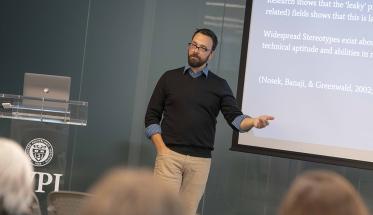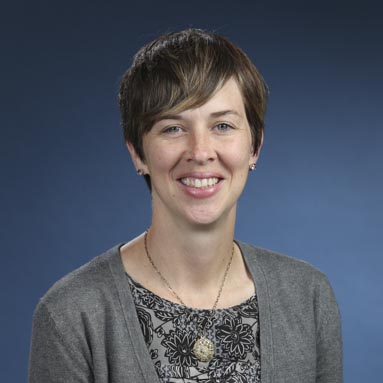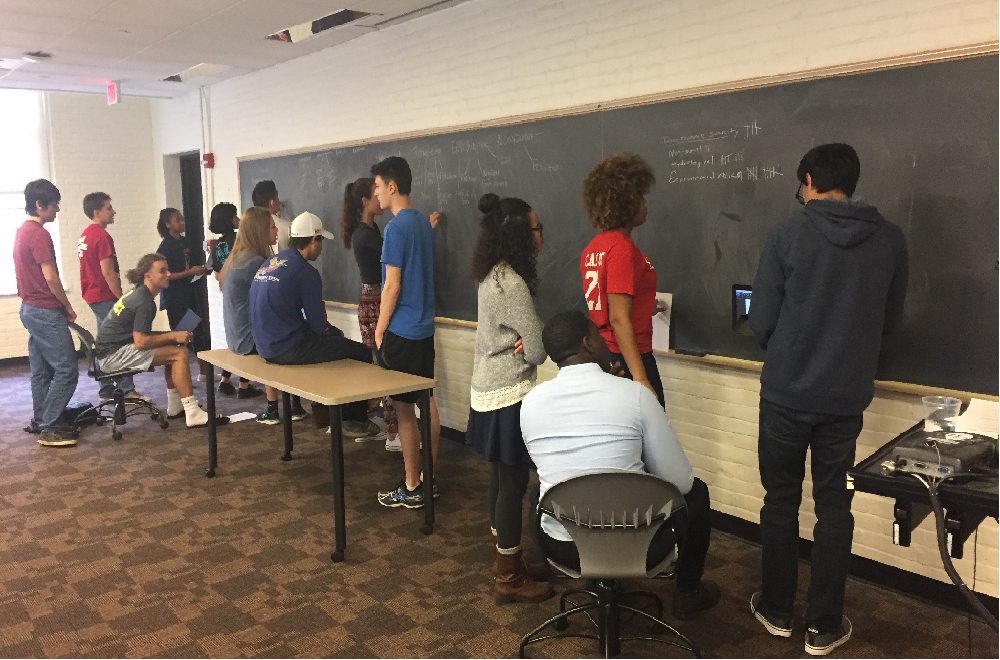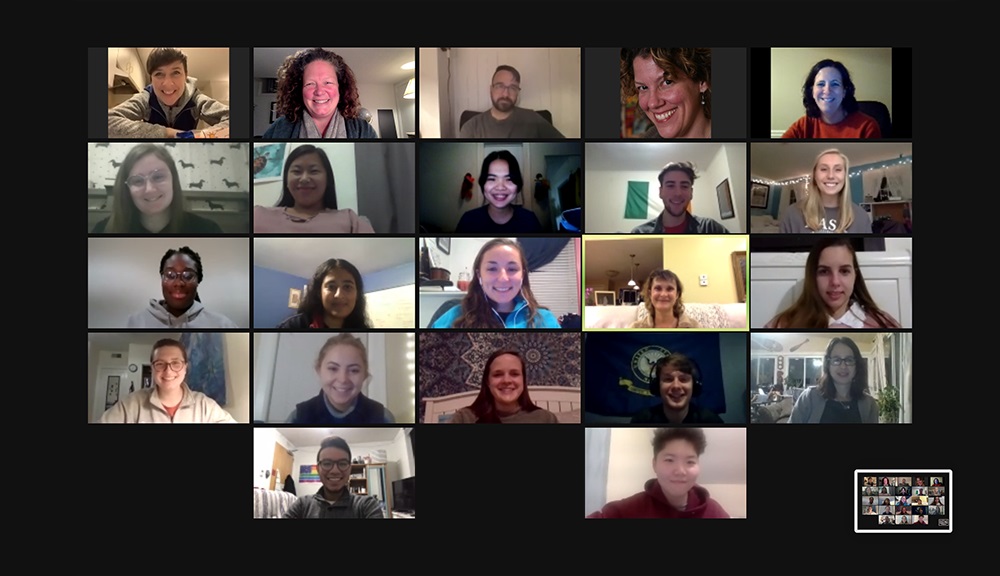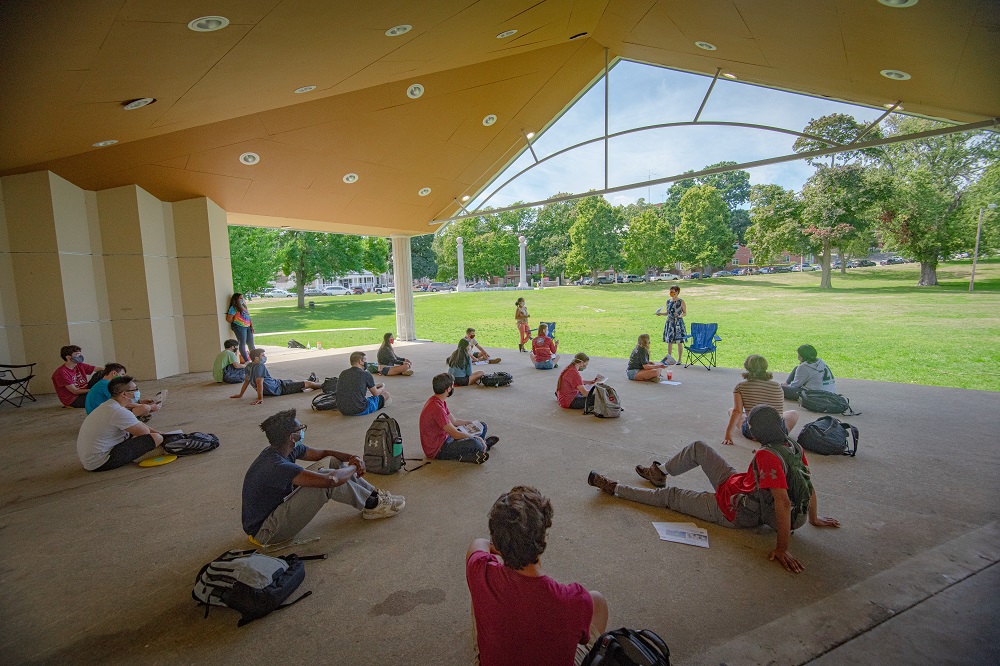Elisabeth Stoddard (assistant teaching professor, Undergraduate Studies) and Geoff Pfeifer (associate teaching professor, Humanities & Arts) brought their strategy and workshop on preventing bias on student project teams to HUBweek earlier this month, knowing that their approach can be applicable off campus in the technology industry and other fields.
During the session, HUBweek participants learned techniques for fostering diversity, inclusion, and equity, and then practiced them in planning tasks on a mock project.
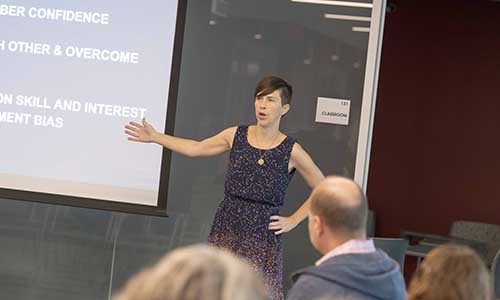
Lisa Stoddard presents to attendees at WPI Seaport during HUBweek.
“This topic, diversity in teams, has a huge impact for us,” said Erik Reidel, a longtime computer engineer and manager who now works as a consultant. “I’ve seen it in my own teams; we see it as a barrier across the industry—people not able to work together, people not getting to the best solutions very quickly.”
“I think they did an excellent job,” Reidel said after the presentation at WPI Seaport. “I think they’ve got some techniques that are potentially applicable. It’ll be interesting to see how those can be applied to more commercial settings. If this is a way for us to operate faster and more effectively, I’m all for it.”
Biotech veteran Fran Perler, who came to the session to see if it could assist her in helping her consulting clients communicate better, sees value in the tools and techniques developed on campus by faculty and others at WPI.
“Although it’s focused on students, many of the things would work outside of that,” she said. “It was very educational and I got a few good ideas.”
The Value of Diverse Ideas
The presentation, “Creating Innovation Through More Equitable Team Dynamics,” and related workshop led to wide-ranging discussions among participants about the value of diverse ideas and approaches on work teams, and the need for communication and transparency among team members.
“When you have a complex problem,” one participant observed, “having diversity of thought helps you solve it better.”
Participants watched a video demonstrating bad team dynamics in which two team members fought over what kind of steel to use, while a third sat by silently, clearly out of the discussion.
“Steamroller,” Casey Gilbert of Portland Downtown said of one of the arguing team members.
“It sort of started out based on facts and then they became personal,” Perler observed. “And the poor woman in the middle is saying, ‘I don’t want to be here.’”
Stoddard and Pfeifer then described their use of a tool called “asset mapping,” which helps students on project teams more equitably divide tasks, with the aim of making the team more effective and the learning experience more successful for all students.
“Although it’s focused on students, many of the things would work outside of that. It was very educational and I got a few good ideas.” -Fran Perler
Students list their assets, which include things like their personal background, courses they have taken, jobs or internship they have had, projects they have worked on, skills they have acquired, and their natural talents, passions, or life experiences. They also include assets they would hope to acquire or improve during the project. Then they share their lists with one another in an exercise of confidence building and awareness, and create a chart that shows the assets of each member and how those can be applied to the project tasks.
As Stoddard and Pfeifer reported in a recently published paper, asset mapping is an effective tool that “addresses and minimizes stereotyping and bias on student teams broadly, but it also does so in a way that offers potential for deeper understanding of the ways bias and stereotyping affect individual students and the team as a whole.”
Equity in Team Project Assignments
The pair began researching student bias and stereotyping in WPI’s first-year Great Problems Seminars program in 2016 after they and other professors identified equity problems in project team assignments that worked against female students and students of color—a situation that is common in STEM disciplines.
Then last academic year, they started using the asset mapping technique in those seminars to make project learning experiences more effective and project teams more equitable.
This year, the use of their tool has been expanded beyond the seminars to 15 more classes across 10 disciplines—including other classroom projects, laboratories and even a class taking place in another country. The effort, known as Supporting WPI through Effective and Equitable Teamwork, or SWEET, has been awarded a $240,000 grant from the Davis Educational Foundation.
A Recurrent Problem in Education and the Work Force
Stoddard and Pfeifer’s work can be applied to nearly any business or organization that relies on a team-based approach to succeed.
“The same problems that happen in STEM education happen in the STEM work force, which leads to a lot of women and people of color leaving STEM once they’ve gotten into it,” said Stoddard.
Stoddard and Pfeifer thought their approach might fit into HUBweek, a week-long festival of ideas, featuring forums, talks, art and tech exhibits and other activities focused on innovation.
“So, when we saw the call for proposals for HUBweek, we realized that these are people in innovation and technology and business, and almost all of them are working on teams,” Stoddard said. “So we pitched it to HUBweek to see if this kind of approach would be helpful for project teams in business and other spaces. And they thought so.”
- By Thomas Coakley
